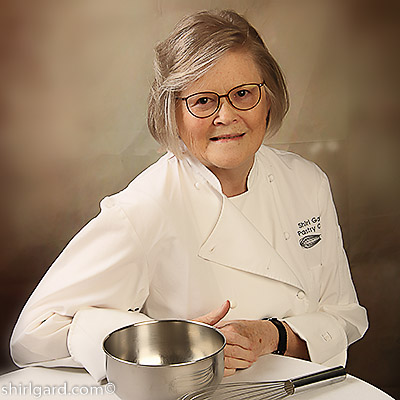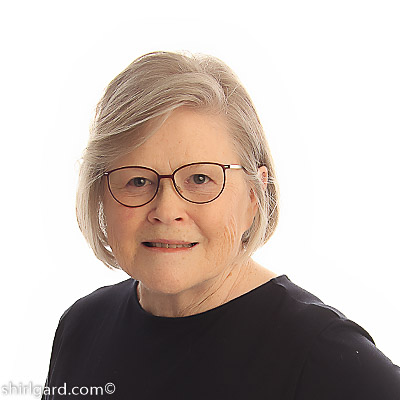About Shirl
Growing up in Oklahoma into a family of bakers provides so many sweet memories. Mother’s specialty was pies. Grandma Draper made bread every Friday of her life, as far as I know, and her light bread, buns, and chocolate cake were all family favorites. Grandma Anderson made wonderful biscuits and strawberry shortcake. As a teenager, I made cherry pies for bake sales, and my Uncle Arnold loved my brownies, made from a recipe in an old Crisco cookbook. After high school, my parents wanted me to become a home economics teacher so I went off to college at Oklahoma State University (I later graduated from the University of Houston) to pursue that path. But a summer job during college at a department store in Dallas changed that plan and led to an exciting and successful fashion career as a buyer and merchandise manager of women’s clothing that involved a lot of buying trips to fun places like New York and Hong Kong. At a certain point when between jobs and wondering what to do next, but having a definite desire to do something different, I attended a luncheon with a friend, where the speaker was talking about career changes for people in the retail business. The message that day was “re-invent yourself”. I’ve heard that phrase many times since, but that was the first time that I remember hearing it. That luncheon speech made such an impression that I decided to go to cooking school (a radical move) and start a whole new career: something in the food business, something I was passionate about. I found that “something” in baking and pastry.
After graduating in 1992 from Peter Kump’s New York Cooking School, now the Institute of Culinary Education (ICE), I started at Wheatleigh, a small luxury hotel near Lenox, MA, working my way up to pastry chef. However, most of my pastry chef career was spent at The Old Inn On The Green, a historical inn built in 1760 as a stagecoach stop on the village green in New Marlborough, MA, in southern Berkshire County. The Old Inn has won many awards, for both food and lodging, including No.1 in the November 2011 Yankee Magazine article: “New England’s Best Historic Inns”. It is owned by Chef Peter Platt and his wife, Meredith Kennard.
One of my many jobs as pastry chef was to write the dessert menus for the Inn and supervise the making of the desserts. All the dessert-making as well as all the baking for both the Inn and The Southfield Store, a casual coffee shop and café located a few minutes down the road from the Inn, and also owned by Peter and Meredith, was done in the bakeshop at the Store. For the Inn, we would make small individual desserts with hints of “fancy” that came from a Tuile Pirouette Cookie here, or some other little touch there, like a triangle of Almond Croquant. Then there would be all of the other components for the menu to be made, like gelato, sorbet, biscotti, and sauces. We would also make all kinds of delicious and beautifully golden-brown baked things: breakfast pastries from croissants and sticky buns to muffins and scones that were needed for breakfast at the Inn as well as for the front counter at the Store. Casual desserts, the opposite of “fancy”, like Fudgy Walnut Brownies, were also part of our repertoire, along with baguettes, cookies, tarts, quiche, granola, wedding cakes, and much more. We also maintained a small wholesale business, selling some of our best products locally: Shirl’s Granola, Shirl’s Gelato, jumbo-size Shirl’s Cookies, and breakfast pastries.
Being a pastry chef requires that you learn something (actually, a lot) about many different specialties, from baking, to ice cream, to plated desserts, to chocolate work, to cake decorating, and many others. I have always been pretty obsessed with learning all of these things and was willing to travel almost anywhere to take the specialty pastry classes that I needed to fill in the gaps and refine my skills. The absolute highlight of all was the petits fours class that I attended in France, at Ecole Lenôtre, near Paris, where the pastry chef for the class was Chef Gérard Gautheron M.O.F. (This Huffington Post article gives a really good explanation of what the coveted M.O.F. title means.) At Lenôtre, I not only learned how to make all kinds of petits fours, but the garnishing and presentation standards for them, as well. Lenôtre is where I learned how to organize a pastry kitchen and to put everything on a scale and weigh it in grams. It is also where I learned that if you want consistent results, preciseness in pastry is extremely important.
Also memorable are all of the different classes I took on the subject of plated desserts. I really owe a lot of thanks to the pastry chefs who taught those classes, which were mostly at the French Pastry School in Chicago. We watched François Payard demo the most beautiful Croque en Bouche, the French wedding cake made of cream puffs, caramel, and pulled sugar, that I had ever seen. En-Ming Hsu invited our whole class to dinner at the Ritz Carlton Hotel, where she was pastry chef, and treated us to a tasting of all the desserts on the menu, carefully explaining all the components of each dessert. The take-away from the Jacquy Pfeiffer class is that it would change forever how I made ice cream and sorbets; he was adamant about using “powders” such as glucose powder and dextrose powder to improve the texture. I remember him saying “go to powders” and I did. From Eric Perez, who is now at the French Pastry School but taught at the Notter School of Pastry Arts in Gaithersberg, MD, when I took his course, I got a great recipe for Chocolate Glaze that we made literally hundreds of times in the bakeshop, and over time, it began to be called not Eric Perez Chocolate Glaze, but just “Eric Perez”. People were always asking me “who is Eric Perez?”. I would have to smile when I would see a bucket of the glaze sitting on the counter and labeled simply: “Eric Perez” (along with the date it was made), because I knew that (without a doubt) everyone who worked in the kitchen knew exactly what it was.
About My Blog
This blog is a way for me to share many of the recipes from my collection and to continue my passion for all things sweet and baked. It is also a way for me to reflect on the many food-related experiences that I have had and includes memoir-like stories that range from “looking back” at a few family recipes (I wish I had more) and stories, to tales from the bakeshop. I also have a strong sense of the importance of “handing down” recipes and want to do my part toward this end. You will see references to old cookbooks (many from my own collection of “vintage” books) as well as observations, opinions, and critiques on current cookbooks and media articles. There are blog posts about what goes into developing a recipe or creating a dessert, and where the inspiration came from. In my “Fancy to Home-y” series, I translate some of my “fancy” restaurant plated desserts to “home-y” desserts: something that you can make for tonight’s dinner or for a Saturday night dinner party. I also love writing about desserts and baked goods from a historical perspective: their back-story, interesting anecdotes, how they were invented, and the history of the pans or molds used to make them. So, there are some posts that include these little history lessons.
There are blurbs where I share practical baking knowledge that I have learned from study, research, and experience over time. In the “A Soupçon of Science” series, I explain why certain things happen in baking. “Baking Bits & Tips” includes mini essays about all sorts of baking and pastry issues. “A Baker’s Pantry” and “A Baker’s Equipment” include detailed information about essential ingredients and equipment culled from my years of baking experience.
About My Recipes
On this site, you will find recipes that I have carefully acquired and developed over the years. These are recipes that I know work, and also taste great, because many of them have been made over and over, tested and retested, many times in a professional bakeshop. Those restaurant-sized recipes will get “whittled down” here to something manageable that we can all make in our home kitchens. I am the happiest when I am creating and developing a recipe because I like the ritual of taking a recipe from inspiration to something tasty and eye-catching; I love all the writing, the making, the baking, the tasting, the tweaking, then repeating the process until it matches my vision. Many recipes include “Recipe Ancestry Notes” that tell you how that recipe came to be, or where it was adapted from, or who or what inspired it.
Since I went to ICE (Institute of Culinary Education), formerly Peter Kump’s New York Cooking School, many of my recipes have roots that lead back to Nick Malgieri, the Director of the Pastry Program; I thank him for all of the great recipes that I used over and over during my pastry career and still use for this blog in adapted versions.
Thanks for stopping by.
I hope you enjoy my recipes along with tips & instructions for making them.
I also hope you like the stories & anecdotes (dollops and pinches of nostalgia) as well as the recipe ancestry notes.
Please feel free to comment on any aspect of my blog or the recipes. I would love to hear from you.
Shirl Gard
Wellington, Florida USA
Updated 7/30/19


